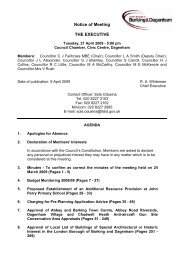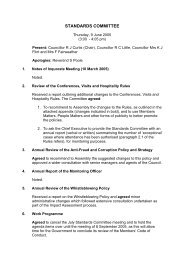Withdrawal of Permitted Development Rights for Houses
Withdrawal of Permitted Development Rights for Houses
Withdrawal of Permitted Development Rights for Houses
Create successful ePaper yourself
Turn your PDF publications into a flip-book with our unique Google optimized e-Paper software.
change <strong>of</strong> use from a use falling within Class C3 (dwelling houses) to a use falling<br />
within Class C4 (houses in multiple occupation) ‘permitted development’ – i.e.<br />
planning permission is no longer needed to do this.<br />
4.2 Under Article 4 <strong>of</strong> the General <strong>Development</strong> Order (as amended) local planning<br />
authorities can make directions withdrawing permitted development rights from<br />
development listed in Schedule 2 <strong>of</strong> the same order. For all article 4 directions the<br />
legal requirement set out in paragraph (1) <strong>of</strong> article 4 <strong>of</strong> the GDO is that the local<br />
planning authority is satisfied that it is expedient that development that would<br />
normally benefit from permitted development rights should not be carried out unless<br />
permission is granted <strong>for</strong> it on an application. This report explains why it is<br />
expedient to withdraw permitted development rights <strong>for</strong> change <strong>of</strong> use from C3 to<br />
C4.<br />
4.3 The Local Authorities (Functions and Responsibilities) (England) Regulations 2000<br />
states that approval to make an Article 4 Direction is not a Cabinet function and<br />
there<strong>for</strong>e must be carried out by Assembly.<br />
5. Other Implications<br />
• Risk Management: Officers consider that there is a legally sound basis <strong>for</strong><br />
making this Article 4 direction. Whilst the Council has to notify the Secretary <strong>of</strong><br />
State when the direction is published it is unlikely he/she would intervene. Please<br />
see the options appraisal section <strong>for</strong> the risks associated with making immediate<br />
and non-immediate directions.<br />
• Contractual Issues: No specific implications.<br />
• Staffing Issues: No specific implications.<br />
• Customer Impact: HMOs make an important contribution to the private rented<br />
sector by catering <strong>for</strong> the housing needs <strong>of</strong> specific groups/households and by<br />
making a contribution to the overall provision <strong>of</strong> af<strong>for</strong>dable or private rented stock.<br />
Whilst black, Asian and other minority ethnic (BAME) communities are probably<br />
disproportionately represented in the HMO stock they are on balance likely to be<br />
advantaged by the Article 4 Direction <strong>for</strong> two reasons. BAME communities are<br />
more likely to require the family housing the Article 4 direction is seeking to<br />
protect and withdrawing permitted development rights will allow the Council more<br />
control over the location <strong>of</strong> small HMOs and there<strong>for</strong>e the associated problems<br />
cited earlier from the CLG Evidence Gathering report. This will be to the benefit <strong>of</strong><br />
all residents.<br />
• Safeguarding Children: Withdrawing permitted development rights will help<br />
preserve the borough’s stock <strong>of</strong> family housing. Many <strong>of</strong> the problems associated<br />
with HMOs cited in the CLG Evidence Gathering report will have an impact on the<br />
environment children are brought up in.<br />
• Health Issues: No specific implications<br />
• Crime and Disorder Issues: The CLG report cited earlier in this report identified<br />
that increased crime was a problem associated with HMOs. There<strong>for</strong>e<br />
withdrawing permitted development rights will help address this impact.

















